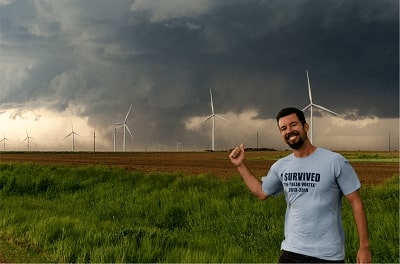Chasing Discovery
 Earth and Ecosystem Science graduate student Cameron Nixon discovers the reason tornadoes can suddenly change direction. During his six-month study, he developed a method to help the National Weather Service issue tornado warnings more effectively. His article, “Anticipating Deviant Tornado Motion Using a Simple Hodograph Technique,” highlights his research into tornado behavior, and his suggested method to improve predictions.
Earth and Ecosystem Science graduate student Cameron Nixon discovers the reason tornadoes can suddenly change direction. During his six-month study, he developed a method to help the National Weather Service issue tornado warnings more effectively. His article, “Anticipating Deviant Tornado Motion Using a Simple Hodograph Technique,” highlights his research into tornado behavior, and his suggested method to improve predictions.
Meteorologists use Doppler radar to track a rotating storm’s paths. Through this process, they determine locations of potential tornadoes and issue warnings accordingly although, some predictions are more difficult than others. At times, tornadoes can change direction unpredictably and may hit a town with little to no warning. Prior to Nixon’s study, meteorologists lacked a method to predict and issue warnings for these tornadoes where the cause of the turns was unknown.
Nixon’s study uncovered the answers for which meteorologists searched. Using Doppler radar, he studied over 100 tornadoes with sudden turns, seven of which he saw with his own eyes as a storm chaser. He evaluated each tornado’s atmospheric condition and the circumstances leading to its formation. By the end of the process, Nixon discovered a pattern in the data.
Rotating storms, which produce tornadoes, move with winds located in the mid-levels of the atmosphere while the tornado itself moves with winds located near the ground. In some cases, the ground-level wind direction is the opposite of the mid-level wind direction. This difference in direction leads to a sudden, unpredictable turn.
Using this new knowledge, Nixon created a forecasting tool that estimates changes in wind direction. When the difference is great enough to change a tornado’s path, the tool alerts forecasters.
With the help of his advisor, Dr. John Allen, Nixon fine-tuned the specifics of his methodology and data display to be effective for forecasters. Nixon’s next step is developing a strategy to teach National Weather Service forecasters about his discovery and accompanying tool. “We hope this will improve the prediction of tornadoes and make sure less come without warning,” Nixon said.
At CMU We Do Research, We Do Real World
Story by ORGS intern Brittney Rudat
March 2021